
(a)
Interpretation: The products for the given reaction including stereoisomers are to be drawn.
Concept introduction: Hydration of
The general steps involved in the hydration reaction are stated below:
• First, protonation of the alkene takes place to generate the carbocation.
• Formation of protonated alcohol.
• Deprotonation.
In this type of reaction, hydroxyl group attacks on the more substituted carbon.
Stereochemistry is defined as the arrangement of molecules in three dimensional space and its impact on
Answer to Problem 10.57P
The products for the given reaction including stereoisomers are shown below.
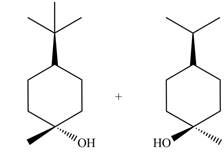
Explanation of Solution
Hydration of alkenes is one of the methods used for the formation of alcohol.
The general steps involved in the hydration reaction are stated below:
• First, protonation of the alkene takes place to generate the carbocation.
• Formation of protonated alcohol.
• Deprotonation.
In this type of reaction, hydroxyl group attacks on the more substituted carbon.
The given reaction is,

Figure 1
The products for the given reaction including stereoisomers are shown below.
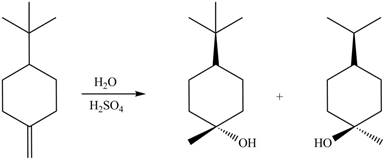
Figure 2
The products for the given reaction including stereoisomers are shown in Figure 2.
(b)
Interpretation: The products for the given reaction including stereoisomers are to be drawn.
Concept introduction: The reaction of hydrogen halide with alkene results in the formation of
Electrophilic addition reactions are those in which breaking of pi bond takes place to form new sigma bond. In this type of reaction, carbocation is formed during the formation of new bond.
Answer to Problem 10.57P
The products for the given reaction including stereoisomers are shown below.

Explanation of Solution
Electrophilic addition reaction follows Markovnikov’s rule. According to Markovnikov’s rule, the positive part of halogen acid attached to that carbon atom in
The steps involved in the electrophilic addition reaction are stated below:
• First, protonation of the alkene takes place to generate the carbocation.
• The halide ion will attack on the carbocation to give the final product.
The given reaction is,
![]()
Figure 3
The products for the given reaction including stereoisomers are shown below.
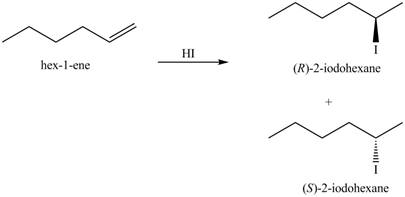
Figure 4
The products for the given reaction including stereoisomers are shown in Figure 4.
(c)
Interpretation: The products for the given reaction including stereoisomers are to be drawn.
Concept introduction: The addition of Halogens to alkenes is a stereospecific reaction. The resultant product is meso compound, if alkene is cis and addition of halogen is syn addition. If addition of halogen is anti, then the resultant products are racemic mixture. In case of trans alkene, the resultant product is meso, if addition of halogen is anti. The resultant products are racemic mixture, if the addition of halogen is syn.
Answer to Problem 10.57P
The products for the given reaction including stereoisomers are shown below.

Explanation of Solution
The general steps involved in the addition of Halogens to alkenes are stated below:
• The first step is the electrophilic attack of halide ion to form a halonium ion.
• The second step is the attack of halide ion from back side to open the halonium ion.
The given reaction is,

Figure 5
The products for the given reaction including stereoisomers are shown below.
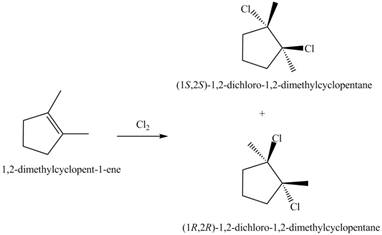
Figure 6
The products for the given reaction including stereoisomers are shown in Figure 6.
(d)
Interpretation: The products for the given reaction including stereoisomers are to be drawn.
Concept introduction: Hydroboration reaction is a two step reaction, which involves conversion of alkene into alcohol. This type of reaction follows anti-Markovnikov’s rule.
Anti markovnikov rule states that the positive part of acid gets attached to that carbon atom in
Anti addition is the addition of any atom from the opposite faces of the double bond of alkene, whereas syn addition is the addition of atom from the same side.
Answer to Problem 10.57P
The products for the given reaction including stereoisomers are given below.
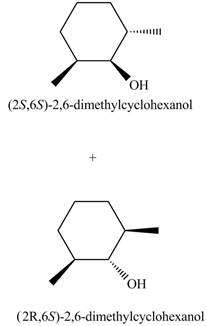
Explanation of Solution
During hydroboration reaction, if boron and hydrogen adds to the double bond of alkene from the same side then it leads to formation of syn addition, whereas if they add from the opposite side then it leads to anti-addition.
The given reaction is,

Figure 7
The products for the given reaction including stereoisomers are shown below.

Figure 8
The products for the given reaction including stereoisomers are shown in Figure 8.
(e)
Interpretation: The products for the given reaction including stereoisomers are to be drawn.
Concept introduction: The reaction of alkene with halogen and water results in the formation of halohydrin product.
Stereochemistry is defined as the arrangement of molecules in three dimensional space and its impact on chemical reactions. Anti stereochemistry is the addition of any atom from the opposite faces of the double bond of alkene, whereas syn addition is the addition of atom from the same side.
The general steps for the formation of halohydrin are stated below:
• The first step is the attack of halide ion to form a halonium ion.
• The second step is the attack of water from back side to open the halonium ion.
• The last step is deprotonation to give the halohydrin product.
Answer to Problem 10.57P
The product for the given reaction including stereoisomers is given below.

Explanation of Solution
The addition of halogens to alkenes is a stereospecific reaction. The resultant product is meso compound, if alkene is cis and addition of halogen is syn addition. If addition of halogen is anti, then the resultant products are racemic mixture. In case of trans alkene, the resultant product is meso, if addition of halogen is anti. The resultant products are racemic mixture, if the addition of halogen is syn addition.
The given reaction is,

Figure 9
The general steps for the formation of halohydrin are stated below:
• The first step is the attack of halide ion to form a halonium ion.
• The second step is the attack of water from back side to open the halonium ion.
• The last step is deprotonation to give the halohydrin product.
The products for the given reaction including stereoisomers are shown below.

Figure 10
The products for the given reaction including stereoisomers are shown in Figure 10.
(f)
Interpretation: The products for the given reaction including stereoisomers are to be drawn.
Concept introduction: The reaction of alkene with halogen and water results in the formation of halohydrin product.
Stereochemistry is defined as the arrangement of molecule in three dimensional and its impact on chemical reactions. Anti stereochemistry is the addition of any atom from the opposite faces of the double bond of alkene, whereas syn addition is the addition of atom from the same side.
The general steps for the formation of halohydrin are stated below:
• The first step is the attack of halide ion to form a halonium ion.
• The second step is the attack of water from back side to open the halonium ion.
• The last step is deprotonation to give the halohydrin product.
Answer to Problem 10.57P
The product for the given reaction including stereoisomers is given below.

Explanation of Solution
The addition of halogens to alkenes is a stereospecific reaction. The resultant product is meso compound, if alkene is cis and addition of halogen is syn addition. If addition of halogen is anti, then the resultant products are racemic mixture. In case of trans alkene, the resultant product is meso, if addition of halogen is anti. The resultant products are racemic mixture, if the addition of halogen is syn addition.
The given reaction is,

Figure 11
The general steps for the formation of halohydrin are stated below:
• The first step is the attack of halide ion to form a halonium ion.
• The second step is the attack of water from back side to open the halonium ion.
• The last step is deprotonation to give the halohydrin product.
The products for the given reaction including stereoisomers are shown below.

Figure 12
The products for the given reaction including stereoisomers are shown in figure 12.
(g)
Interpretation: The products for the given reaction including stereoisomers are to be drawn.
Concept introduction: Hydration of alkenes is one of the methods used for the formation of alcohol.
The general steps followed by hydration reaction are stated below:
• First, protonation of the alkene takes place to generate the carbocation.
• Formation of protonated alcohol.
• Deprotonation.
In this type of reaction, hydroxyl group attacks on the more substituted carbon.
Stereochemistry is defined as the arrangement of molecule in three dimensional and its impact on chemical reactions. Stereochemistry for the products is shown by the dashed and wedge lines. Dashed lines represent that the bond is far away from the plane, whereas wedge line represents the bond out of the plane and towards the observer. These lines are used to represent the stereochemistry of the compound.
Answer to Problem 10.57P
The products for the given reaction including stereoisomers are shown below.

Explanation of Solution
The addition of Halogens to alkenes is a stereospecific reaction. The resultant product is meso compound, if alkene is cis and addition of halogen is syn addition. If addition of halogen is anti, then the resultant products are racemic mixture. In case of trans alkene, the resultant product is meso, if addition of halogen is anti. The resultant products are racemic mixture, if the addition of halogen is syn addition.
The given reaction is,

Figure 13
The reaction of
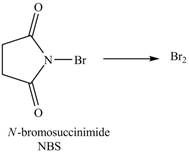
Figure 14
The general steps for the formation of halohydrin are stated below:
• The first step is the attack of halide ion to form a halonium ion.
• The second step is the attack of water from back side to open the halonium ion.
• The last step is deprotonation to give the halohydrin product.
The products for the given reaction including stereoisomers are shown below.

Figure 15
The attack of water on halonium ion is from back side that opens the bromonium ion to form mixture of enantiomers. This shows that the mode of addition in this reaction is anti which gives trans enantiomers.
The products for the given reaction including stereoisomers are shown in figure 15.
(h)
Interpretation: The products for the given reaction including stereoisomers are to be drawn.
Concept introduction: Hydration of alkenes is one of the methods used for the formation of alcohol.
The general steps followed by hydration reaction are stated below:
• First, protonation of the alkene takes place to generate the carbocation.
• Formation of protonated alcohol.
• Deprotonation.
In this type of reaction, hydroxyl group attacks on the more substituted carbon.
Stereochemistry is defined as the arrangement of molecule in three dimensional and its impact on chemical reactions. Stereochemistry for the products is shown by the dashed and wedge lines. Dashed lines represent that the bond is far away from the plane, whereas wedge line represents the bond out of the plane and towards the observer. These lines are used to represent the stereochemistry of the compound.
Answer to Problem 10.57P
The products for the given reaction including stereoisomers are shown below.
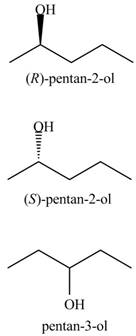
Explanation of Solution
Hydration of alkenes is one of the methods used for the formation of alcohol.
The general steps followed by hydration reaction are stated below:
• First, protonation of the alkene takes place to generate the carbocation.
• Formation of protonated alcohol.
• Deprotonation.
In this type of reaction, hydroxyl group attacks on the more substituted carbon.
The given reaction is,

Figure 16
The products for the given reaction including stereoisomers are shown below.
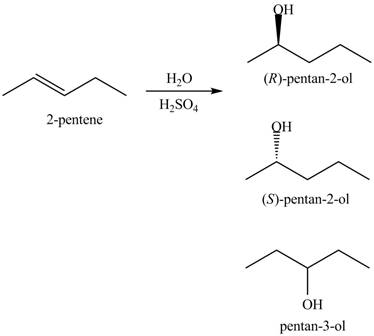
Figure 17
Stereochemistry is defined as the arrangement of molecule in three dimensional and its impact on chemical reactions. Stereochemistry for the products is shown by the dashed and wedge lines. Dashed lines represent that the bond is far away from the plane, whereas wedge line represents the bond out of the plane and towards the observer. These lines are used to represent the stereochemistry of the compound.
The products for the given reaction including stereoisomers are shown in figure 17.
Want to see more full solutions like this?
Chapter 10 Solutions
Organic Chemistry
- Draw the major product of this reaction. Ignore inorganic byproducts and the carboxylic acid side product. O 1. CHзMgBr (excess) 2. H₂O ✓ W X 人arrow_forwardIf cyclopentyl acetaldehyde reacts with NaOH, state the product (formula).arrow_forwardDraw the major product of this reaction. Ignore inorganic byproducts. N S S HgCl2, H2SO4 く 8 W X Parrow_forward
- tab esc く Drawing the After running various experiments, you determine that the mechanism for the following reaction occurs in a step-wise fashion. Br + OH + Using this information, draw the correct mechanism in the space below. 1 Explanation Check F2 F1 @2 Q W A os lock control option T S # 3 80 F3 Br $ 4 0105 % OH2 + Br Add/Remove step X C F5 F6 6 R E T Y 29 & 7 F D G H Click and drag to start drawing a structure. © 2025 McGraw Hill LLC. All Rights Reserved. Terms of Use | Privacy Ce A F7 DII F8 C Ո 8 * 9 4 F10 F C J K L C V Z X B N M H command P ge Coarrow_forwardIndicate compound A that must react with ethylbenzene to obtain 4-ethylbenzene-1-sulfonic acid. 3-bromo-4-ethylbenzene-1-sulfonic acid.arrow_forwardPart 1 of 2 Draw the structure of A, the minor E1 product of the reaction. esc I Skip Part Check H₂O, D 2 A + Click and drag to start drawing a structure. -0- F1 F2 1 2 # 3 Q A 80 F3 W E S D F4 $ 4 % 5 F5 ㅇ F6 R T Y F G X 5 & 7 + Save 2025 McGraw Hill LLC. All Rights Reserved. DII F7 F8 H * C 80 J Z X C V B N 4 F9 6arrow_forward
- File Preview The following is a total synthesis of the pheromone of the western pine beetle. Such syntheses are interesting both because of the organic chemistry, and because of the possibility of using species specific insecticides, rather than broad band insecticides. Provide the reagents for each step. There is some chemistry from our most recent chapter in this synthesis, but other steps are review from earlier chapters. (8 points) COOEt COOEt A C COOEt COOEt COOH B OH OTS CN D E See the last homework set F for assistance on this one. H+, H₂O G OH OH The last step is just nucleophilic addition reactions, taking the ketone to an acetal, intramolecularly. But it is hard to visualize the three dimensional shape as it occurs. Frontalin, pheromone of the western pine beetlearrow_forwardFor the reaction below: 1. Draw all reasonable elimination products to the right of the arrow. 2. In the box below the reaction, redraw any product you expect to be a major product. C Major Product: Check + ◎ + X ง © Cl I F2 80 F3 I σ F4 I F5 NaOH Click and drawing F6 A 2025 McGraw Hill LLC. All Rights E F7 F8 $ # % & 2 3 4 5 6 7 8 Q W E R T Y U A S D F G H Jarrow_forwardCan I please get help with this graph. If you can show exactly where it needs to pass through.arrow_forward
- N Draw the major product of this reaction. Ignore inorganic byproducts. D 1. H₂O, pyridine 2. neutralizing work-up V P W X DE CO e C Larrow_forwardDraw the major product of this reaction. Ignore inorganic byproducts. N O' 1. H2O, pyridine 2. neutralizing work-up く 8 W aarrow_forwardIdeal Gas Law Practice Name If you need a refresher on Ideal Gas Law, go back to your Ideal Gas Law Reading Assignment from last week! On all of the following, you'll need to make sure to convert pressures to atm and convert temperatures to Kelvin in order to be able to use the R gas constant on your equation sheet! Given: Ideal Gas Law = then P= pressure V = volume R= ideal gas consent PV=nRT namount of substance n=PV/TR P=nRT/V I = temperature V=nRT/P T=PV/nR R=PV/nT 1. What pressure is required to contain 0.023 moles of nitrogen gas in a 4.2 L container at a temperature of 20.°C? 2. Oxygen gas is collected at a pressure of 123 kPa in a container which has a volume of 10.0 L. What temperature must be maintained on 0.500 moles of this gas in order to maintain this pressure? Express the temperature in degrees Celsius. 3. How many moles of chlorine gas would occupy a volume of 35.5 L at a pressure of 100.0 kPa and a temperature of 100. °C? After determining the number of moles,…arrow_forward
 Chemistry for Today: General, Organic, and Bioche...ChemistryISBN:9781305960060Author:Spencer L. Seager, Michael R. Slabaugh, Maren S. HansenPublisher:Cengage Learning
Chemistry for Today: General, Organic, and Bioche...ChemistryISBN:9781305960060Author:Spencer L. Seager, Michael R. Slabaugh, Maren S. HansenPublisher:Cengage Learning
